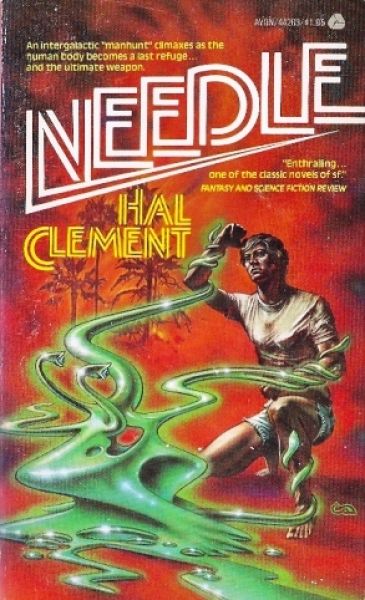Flowing Through My Veins
Needle
By Hal Clement

29 Mar, 2020
Hal Clements’ 1950 Needle is a science fiction mystery.
In hot pursuit of a killer, the Hunter and his quarry crash land on Earth. The Hunter survives the landing. It must assume the criminal did as well. Determined to catch the criminal, the Hunter must turn to local allies for help.
The catch? Earth has never been contacted by anything like the Hunter and its prey. The Hunter must manage not just detection, but first contact.
A four-pound blob, the Hunter is an obligate symbiote, a being that lives commensally with a host. The Hunter and its kind have spent thousands of years experience co-existing with its partner races and no time at all with any terrestrial species. It takes the Hunter some time to determine which species would best serve its purpose, and to make its way inside one: fourteen-year-old Robert Kinnaird.
The Hunter’s timing is unfortunate: the Pacific Island on which Robert and his family (and more importantly, the killer) live is halfway across the planet from the boarding school to which Robert is dispatched almost as soon as the Hunter infiltrates him. The Hunter is on the wrong side of the world from the killer he is chasing, in a host with whom he cannot communicate.
Hard work and diligence bridge the communication barrier. Robert agrees to help catch the killer. The Hunter’s control of Robert’s physiology facilitates a return to Robert’s home island. By the time all this occurs, five months have passed.
The only good news is that the fugitive is probably still on the island. There are more than a hundred people on the island within whom the killer could be hiding (assuming it is not living within an animal). The host is almost certainly unaware of what it carries. The Hunter and Robert begin what could be a laborious investigation.
They may not have that much time. Not only might the fugitive managed to escape the island, but it may be aware the pair are hunting for him. The fugitive won’t hesitate to kill to protect itself.
~oOo~
This was one of the first SF mysteries, which got around the usual objection (that the writer could pull any whiz-bang tech rabbit out of the hat to provide the detective with the answer) by carefully constraining the setting. The Hunter lost any high-tech gear — no helpful truth-ray or Absorbascon—when it crashed and the Earth (the 1950s Earth, as of time of publication) wasn’t the tech utopia it is now.
The process of working out how to talk to Robert took up much more of the story than I remembered. More than a quarter of the book is spent dealing with that basic issue, which admittedly serves the purpose of giving the quarry time enough to find a place to hide on the island.
Because this is Hal Clement, whose characters are always essentially reasonable people, no significant amount of time is lost while Robert freaks out over being invaded by an alien snot-monster or even over the fact he no longer has any privacy. The characters are also extremely pragmatic: the Hunter offhandedly kills its first host because it is just a shark, a lower-order animal on whose well-being it places no value. The question of how to imprison the quarry once they catch it isn’t an issue because imprisoning it isn’t the goal.
The mystery itself is solved fair and square, from inadvertent clues left by the quarry. The prose … you know, people who are looking for gemlike prose probably shouldn’t pick up a Clement novel in the first place. The prose does its job, which is to get out of the way of the puzzle.
Needle is included in this NESFA Press omnibus.
